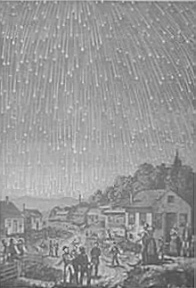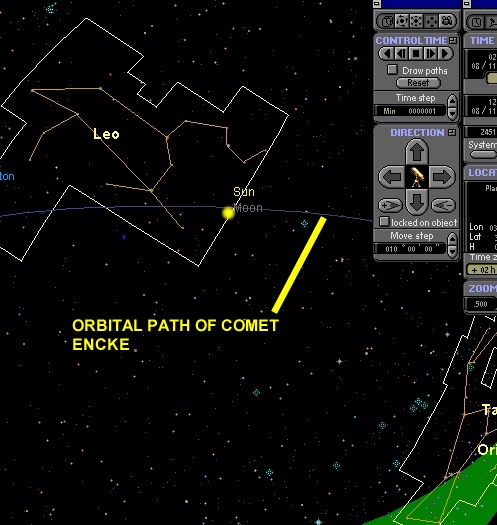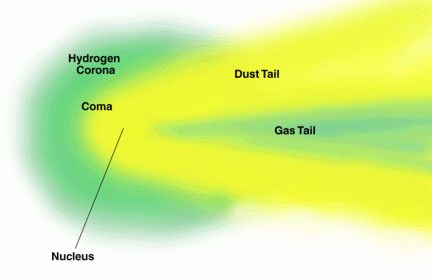THE DANGER AND THE DEFENSE
A cosmic trail with destruction in its wake
by Nick Nuttall
Copyright 1990 Times Newspapers Limited The Times, May 24, 1990, Thursday
Over the next few weeks the Taurid stream, a procession of vast cosmic rubble
and dust that snakes around the Sun and out towards Jupiter, will swing through
Earth's orbit for the first of its bi-annual crossings.
Within the stream are probably thousands of bodies including asteroids,
mountain-and island-sized boulders, smaller meteoroids, Encke's Comet and
assorted fragments of celestial refuse.
The exact number, size and location of objects, however, remains a mystery
and according to Dr. Mark Bailey, research Fellow in astronomy at Manchester
University, it is likely that for every object which is confirmed, there
are nine others that have so far eluded detection.
All that is certain is that the rubble, believed by some astronomers to have
been formed by a collision in the asteroid belt of a defunct comet which
was captured by the solar system up to 30,000 thousand years ago, will bisect
Earth's orbit in late June and again in November.
According to astronomers such as Dr. Victor Clube, of Oxford University's
Department of Astrophysics, the coming and goings of the Taurid stream should
be a source of concern to politicians, planners and anyone who cherishes
life on Earth.
A ''catastrophist'', Dr. Clube is one of many astronomers who are convinced
that within this celestial procession lie the seeds of mass destruction an
Armageddon of biblical proportions. ''The matter requires urgent attention.
It is crucial that everyone is woken up to the danger,'' Dr. Clube says.
The chilling scenario envisaged is of Earth and one of the 46,000mph objects
in the Taurid stream colliding during one of the orbital crossings.
Dr. Clube says: ''It is analagous to a nuclear war with a megatonnage of
the same order and all the effects of nuclear war with debris from the impact
causing sunlight to be blocked causing a Dark Age or Ice Age.''
He has coined the phrase ''Multiple Tunguska Bombardment'' to describe the
worst nightmare which, he believes, will eventually happen. Tunguska refers
to a Siberian River near which, in June 1908, a 100 yard body from the Taurid
stream ploughed into Earth, exploding and devastating an area 25 miles wide
with the impact of a 20-megaton bomb.
Fortunately the encounter occured in an unpopulated part of the globe but
if the impact had been on London it would have devastated the city, killing
millions. The Tunguska event may have been only a chance occurence.
Yet, according to Dr. Clube and Dr. Bill Napier, of the Royal Observatory
in Edinburgh, whose book Cosmic Winter is published next month, the history
of Earth is littered with subtle evidence that cosmic debris have consistently
intervened, often with catastrophic consequences.
One of the most popular theories to explain the sudden demise of the dinosaurs
is that, 65 million years ago, a huge asteroid ploughed into the planet,
triggering either a nuclear-style winter or huge fires.
This popular theory was given a boost only last week when scientists at the
University of Arizona reported the discovery of an apparent 180-mile-wide
crash site in the Caribbean of an asteroid six miles wide. They claim this
could be linked with the great reptiles' extinction.
Dr. Clube ascribes other events including the Old Testament story of Noah
and his Ark to a Dark Age linked with colliding heavenly bodies. He also
believes that climatic changes, including fears of present global warming,
may have a cosmic component.
There is sufficient evidence, he says, to indicate that collisions happen
within centuries and millenniums rather than millions and billions of years,
with multiple encounters more likely than sceptics claim.
Dr. Clube emphasizes that predicting when a bombardment may occur is impossible
without more scientific evaluation of the Taurid stream.
''We are probably a little safer at the moment because the intersecting orbits
are far away. But we are on the inward run and in 500 years we will start
getting close again,'' he says.
According to Dr. Clube, the last time that the stream was closest within
Earth's orbit was in the first millennium BC, from about 500BC up to 0AD,
the time of Christ.
It is vital to overcome complacency about the threat from cosmic debris,
he says. This complacency is relatively new, as pagan and ancient civilisations
such as the Babylonians were firm believers in the threat of of cosmic
destruction. Part of the blame for this complacency rests with the breakup,
in 1845, of Comet Biela without any easily visible effect on Earth.
''This rather relaxed attiude to comets, which has persisted to the present
day, helped turn 19th century opinion against a prevailing catastrophist
view of evolution,'' Dr. Clube says.
''Indeed, the eventual disintegration of Comet Biela into dust made it no
longer out of place for biologists and geologists to explain evolution in
processes that were non-violent and slow-acting.''
''In short, it became fashionable to assume that the world is safe when in
fact multiple Tunguska bombardments, releasing around five-thousand megatons,
the equivalent of a full-scale nuclear war, may happen at intervals of about
1,500 years, producing a Dark Age,'' he says.''To suggest the planet is safe
is absurd.''
The Oxford astrophysicist is not alone in his views. Similar concerns were
echoed last week by the respected American Institute of Aeronautics and
Astronautics (AIAA).
The institute is calling for studies aimed at defending the Earth from asteroid
attack, including the possible redeployment of nuclear weapons to shatter
incoming celestial bodies.
The call comes in the wake of thawing East-West relations and what is being
claimed as a recent, potentially disastrous near-collision.
Last year, 1989 FC, a cosmic boulder bigger than an aircraft carrier, passed
within 400,000 miles of Earth, a mere whisker in astronomical terms, before
being noticed by astronomers.
''Such an object could cause a disaster of unprecedented proportions if it
had struck. Although the probability is very small, its consequences in terms
of the casuality rate could be enormous,'' the institute argues in a paper
it released about the problem.
Apart from putting nuclear warheads on standby for intercepting and shattering
asteroids, the institute is calling for studies into power units that could
attach and divert the celestial boulders away from Earth.
''We have the technology needed to detect and track such an object and possibly
to divert if from an impending impact. We would be derelict if we did nothing,''
the institute says.
Dr. Clube is hoping to get access to an infra-red telescope to study the
Taurid stream during the November crossover.
In 1983, a satellite revealed what appeared to be dust following Comet Encke,
but some scientists, including Dr. Clube, now believe that this contains
the single large missing body, perhaps as large as 20 miles wide, shrouded
in dust and boulders.
The best chance of detecting the defunct comet might come in 1994 when the
American National Aeronautics and Space Administration (Nasa) is expected
to launch the infra-red telescope, ISO.
Dr. Bailey says: ''We are learning more about these objects almost every
week. We are realizing that there are quite a large number of fairly large
objects, ranging in size from just a few hundred yards to six miles across,
which are in Earth's collision orbit.''
Along with Dr. Bailey, Dr. Clube supports the institute's call for improved
monitoring. But both British astronomers are concerned at suggestions of
shattering incoming asteroids.
They believe that there is the danger that by solving one large threat, it
may create scores of smaller ones. Cosmic Winter by Dr. Victor Clube and
Dr. Bill Napier. Published in June by Basil Blackwell (Pounds 16.95). The
Origin of Comets by Dr. Mark Bailey, Dr. Victor Clube and Dr. Bill Napier.
Pergamon Press. |


